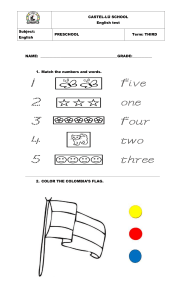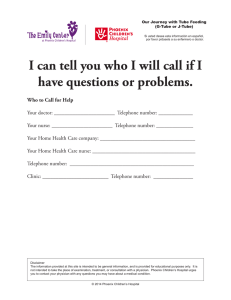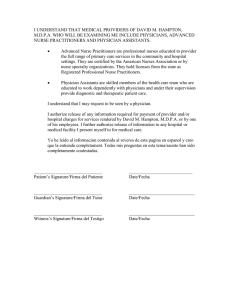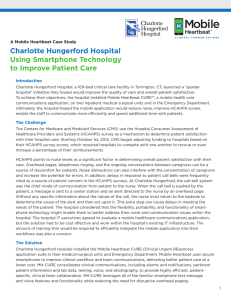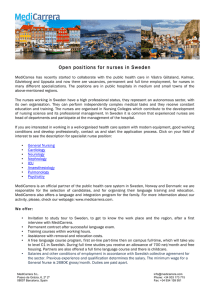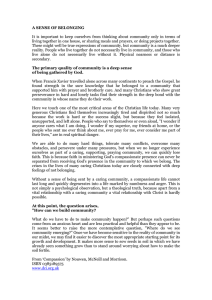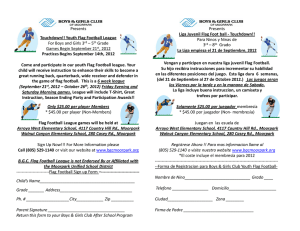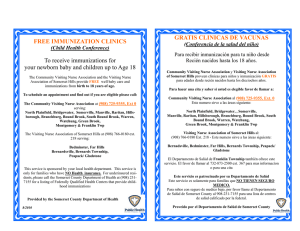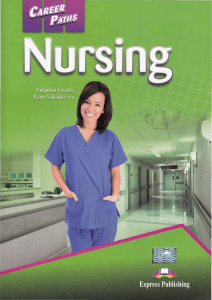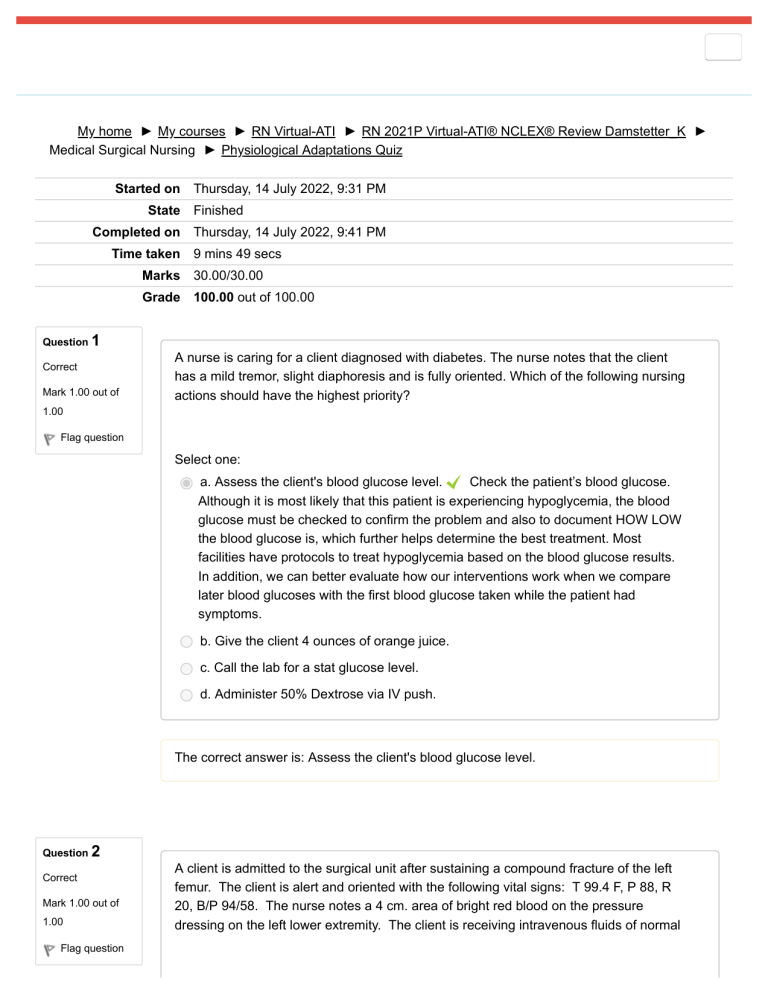
My home ► My courses ► RN Virtual-ATI ► RN 2021P Virtual-ATI® NCLEX® Review Damstetter_K ► Medical Surgical Nursing ► Physiological Adaptations Quiz Started on Thursday, 14 July 2022, 9:31 PM State Finished Completed on Thursday, 14 July 2022, 9:41 PM Time taken 9 mins 49 secs Marks 30.00/30.00 Grade 100.00 out of 100.00 Question 1 Correct Mark 1.00 out of A nurse is caring for a client diagnosed with diabetes. The nurse notes that the client has a mild tremor, slight diaphoresis and is fully oriented. Which of the following nursing actions should have the highest priority? 1.00 Flag question Select one: a. Assess the client's blood glucose level. Check the patient’s blood glucose. Although it is most likely that this patient is experiencing hypoglycemia, the blood glucose must be checked to confirm the problem and also to document HOW LOW the blood glucose is, which further helps determine the best treatment. Most facilities have protocols to treat hypoglycemia based on the blood glucose results. In addition, we can better evaluate how our interventions work when we compare later blood glucoses with the first blood glucose taken while the patient had symptoms. b. Give the client 4 ounces of orange juice. c. Call the lab for a stat glucose level. d. Administer 50% Dextrose via IV push. The correct answer is: Assess the client's blood glucose level. Question 2 Correct Mark 1.00 out of 1.00 Flag question A client is admitted to the surgical unit after sustaining a compound fracture of the left femur. The client is alert and oriented with the following vital signs: T 99.4 F, P 88, R 20, B/P 94/58. The nurse notes a 4 cm. area of bright red blood on the pressure dressing on the left lower extremity. The client is receiving intravenous fluids of normal saline at 150 ml/hr. One hour after being admitted to the unit, the nurse finds the client confused and combative. Which of the following is the most likely cause of the change in the client’s condition? Select one: a. Fluid overload related to aggressive isotonic volume replacement b. Hypovolemic shock related to hemorrhage from the open wound c. Hypoxia related to fat embolism from the fractured bone. Although the mechanism is not really clear, it is thought that in compound long bone fractures the internal pressure in the fracture forces fat globules from the marrow into the systemic circulation, where they act as emboli. Initial symptoms within 24-48 hours post-fracture include confusion and combativeness secondary to hypoxemia. d. Infectious process related to contamination of the open wound. The correct answer is: Hypoxia related to fat embolism from the fractured bone. Question 3 Correct Mark 1.00 out of A nurse is caring for a client on the telemetry unit who is two days post coronary artery bypass grafting (CABG). The nurse recognizes a cardiac rhythm change from normal sinus rhythm to atrial fibrillation. Which of the following should be completed first? 1.00 Flag question Select one: a. Prepare a diltizem drip. b. Notify the health care provider. c. Prepare the client for cardioversion. d. Assess the client’s blood pressure. Atrial fibrillation frequently occurs after CABG. In A-Fib the atrial kick is lost and cardiac output (C.O.) is decreased by 30%. Clients react differently to A-Fib and the decreased C.O. Some clients become hypotensive and develop shock-like symptoms: changes in LOC; cool, clammy skin; dyspnea; and chest pain. While other clients are normotensive despite the decrease in C.O., they are asymptomatic or considered stable. Treatment for A-Fib depends on the status of the client. The first action the nurse should take with a client who has converted from NSR to A-Fib is to assess the clients BP. The correct answer is: Assess the client’s blood pressure. Question 4 Correct The nurse is planning care for a client who is prescribed antiembolic stocking following abdominal surgery. Which of the following interventions should the nurse include? Mark 1.00 out of 1.00 Flag question Select one: a. Ensure stockings are loose fitting over client’s calves. b. Encourage client to only wear stockings when out of bed. c. Remove stocking every 2 hours then reapply after 1 hour off. d. Remove stockings one to three times per day for skin care and inspection. Antiembolic stockings should be removed one to three times per day to allow for skin care and assessment. The client’s extremities should be monitored for calf pain, warmth, erythema and edema. The correct answer is: Remove stockings one to three times per day for skin care and inspection. Question 5 Correct Mark 1.00 out of A nurse is teaching lifestyle modifications to a client diagnosed with hypertension. Which of the following statements made by the client indicates a need for further teaching? 1.00 Flag question Select one: a. “I don’t like to walk, but I do aerobics and work out at the gym during the week.” b. “We have a glass of wine a couple of times a week with dinner.” c. “Losing weight is so hard, but so far I am losing 2 pounds a week.” d. “I will substitute mushrooms for the bacon in my daily omelets.” Daily omelets are not recommended as eggs are high in cholesterol and can lead to an increase in blood pressure due to promotion of atherosclerosis. The correct answer is: “I will substitute mushrooms for the bacon in my daily omelets.” Question 6 Correct A nurse is caring for a client with Addison's disease. Which of the following diets should the nurse teach the client to follow? Mark 1.00 out of 1.00 Flag question Select one: a. Low Sodium, high calcium and decreased fluids. b. High Sodium, low potassium and increased fluids. The client with Addison's disease should have a diet high in sodium, low in potassium and increased fluids. In addition, these clients should be encouraged to consume small frequent meals to prevent hypoglycemia. c. Low Sodium, high potassium and decreased fluids. d. High Sodium, low calcium and increased fluids. The correct answer is: High Sodium, low potassium and increased fluids. Question 7 Correct A nurse is caring for a client who is experiencing a sodium level of 119 mEq/L. Which nursing action would be most appropriate at this time? Mark 1.00 out of 1.00 Flag question Select one: a. Monitor for diminished breath sounds. b. Administer 0.9% Normal Saline. Administering of isotonic IV therapy would be appropriate at this time for restoration of normal ECF volume. c. Provide oral hygiene and comfort measures. d. Encourage water and other fluids. The correct answer is: Administer 0.9% Normal Saline. Question 8 Correct Mark 1.00 out of A nurse is caring for a client with diabetes insipidus (DI) who has been prescribed aqueous vasopressin. Which of the following outcomes indicates that treatment has been effective? 1.00 Flag question Select one: a. Blood pressure of 90/50 mm Hg b. Pulse rate of 126 beats/minute c. Fluid intake of 2,400mL in 24 hours DI is characterized by polyuria (up to 8L/day), constant thirst, and an unusually high oral intake of fluids. Treatment with Lypressin should decrease the urine output and oral fluid intake. d. Urine output of 200mL per hour The correct answer is: Fluid intake of 2,400mL in 24 hours Question 9 Correct Which of the following should the nurse use to determine the neurological status of a client with a head injury? Mark 1.00 out of 1.00 Flag question Select one: a. Respiratory rate b. Client’s reported pain scale c. Manifestations of seizure activity d. The Glasgow Coma Scale The Glasgow Coma Scale (GCS) is used to determine the client’s level of consciousness (LOC). This is done with a head injury client at regular intervals, because LOC changes precede all other changes in vital and neurological signs. Each response is scored to predetermined criteria. The score is calculated numerically and the higher the score the higher the functioning. The correct answer is: The Glasgow Coma Scale Question 10 Correct Mark 1.00 out of 1.00 Flag question A client is admitted to the medical unit from the convalescent center for treatment of urosepsis. The client’s adult daughter reports to the nurse, “I don’t know what to do. I love my mom and would like to have her live in my home, but I just can’t be with her every minute, and that’s what she needs now.” Which of the following would be the best approach to improve integration of the elderly mother into the family structure? Select one: a. Offer to refer the daughter to a counselor in an effort to better deal with her feelings of guilt. b. Determine if the daughter would consider having the client visit in her home one day a week. Even if it is not feasible for the elderly parent to live full-time with the adult child, it may be very feasible for the parent to visit the adult child’s home and integrate into the family structure for hours at a time, or even overnight. Using that approach, the adult daughter could structure time to be exclusively with the adult parent without it being full-time. c. Suggest that the daughter move the client into the family home on a trial basis for several weeks. d. Assist the daughter in finding a caregiver who can assist the client in the convalescent center. The correct answer is: Determine if the daughter would consider having the client visit in her home one day a week. Question 11 Correct A nurse is reviewing a client’s lab results. Which finding would lead the nurse to suspect the client is experiencing dehydration? Mark 1.00 out of 1.00 Flag question Select one: a. Serum sodium 130 mEq/L b. Urine specific gravity of 1.025 c. BUN 20mg/100mL d. Hematocrit 55% dehydration. An increased hematocrit level (>50%) is expected with The correct answer is: Hematocrit 55% Question 12 Correct A nurse is caring for a toddler who is being treated for hypovolemia. Which of the following demonstrates to the nurse the desired response to fluid replacement? Mark 1.00 out of 1.00 Flag question Select one: a. Specific Gravity 1.025 Specific gravity falls within normal range of 1.0101.030 and indicates successful fluid replacement. b. Apical heart rate 130 beats/min c. Urine output 48 mL for the past 4 hours d. Central Venous Pressure 2 mm Hg The correct answer is: Specific Gravity 1.025 Question 13 Correct A nurse is caring for a client recovering from an abdominal aortic aneurysm (AAA) repair. Which of the following findings would have the highest priority? Mark 1.00 out of 1.00 Flag question Select one: a. Pedal pulse amplitude 2+. b. Respiratory rate 12 breaths/minute. c. Urine output 28 ml/hour d. Blood pressure 136/90 mmHg Blood pressure is critically monitored to maintain a normal BP so as to protect the newly placed aortic graft. This elevated BP is the most critical assessment finding that could result in serious consequences such as rupture of the aneurysm repair if not addressed quickly. The correct answer is: Blood pressure 136/90 mmHg Question 14 Correct Mark 1.00 out of A nurse is caring of a client recently diagnosed with diabetes mellitus (DM). Which of the following is the physiologic basis for the polyuria manifested by individuals with untreated DM? 1.00 Flag question Select one: a. Chronic stimulation of the detrusor muscle by the ketone bodies in the urine b. Early-stage renal failure causes a loss of urine concentrating capacity c. Inadequate secretion of antidiuretic hormone (ADH) d. Hyperosmolarity of the extracellular fluids secondary to hyperglycemia Hyperosmolarity of the extracellular fluids secondary to hyperglycemia: The hyperosmolarity of the extracellular fluids causes fluid to leak out of the cells in order to return the body to an isotonic state; hence there is increased intravascular fluid the kidneys must excrete. The correct answer is: Hyperosmolarity of the extracellular fluids secondary to hyperglycemia Question 15 Correct Mark 1.00 out of A client diagnosed with atrial fibrillation has a pacemaker set at a ventricular rate of 70 beats per minute. Which of the following findings should the nurse immediately report to the provider? 1.00 Flag question Select one: a. HR= 96 beats/minute and irregular b. HR= 96 beats /minute and regular c. HR= 76 beats/minute and irregular d. HR= 60 beats /minute and regular The pacer should have fired when native heart rate was less than 70. Pacers have a variety of modes but in each mode used, the “demand” rate determines when they will begin to fire if the heart itself has not supplied an electrical impulse. The correct answer is: HR= 60 beats /minute and regular Question 16 Correct Mark 1.00 out of A client with chronic obstructive pulmonary disease (COPD) has oxygen therapy ordered. Which principle should guide the nurse in managing the delivery of oxygen to this client? 1.00 Flag question Select one: a. The concentration of oxygen should be high since the stimulus to breathe in clients with COPD is an elevated PaCO2. b. Clients with COPD should receive low concentrations (2-3 L) of oxygen since the stimulus to breathe is their low PaO2. Clients with COPD should receive low concentrations (2-3 L) of oxygen since the stimulus to breathe is their low PO2. c. The concentration of oxygen should be low since the stimulus to breathe in clients with COPD is an elevated PaCO2. d. Clients with COPD require higher concentrations (6-8 L) of oxygen since hypoxemia is their stimulus to breathe. The correct answer is: Clients with COPD should receive low concentrations (2-3 L) of oxygen since the stimulus to breathe is their low PaO2. Question 17 Correct Mark 1.00 out of A nurse is caring for a client who is intubated and receiving ventilatory assistance. The high pressure alarm is sounding on the ventilator. Which of the following would have the highest priority? 1.00 Flag question Select one: a. Check the endotracheal tube (ETT) to be sure there is no disconnection. b. Administer sedation to calm the client’s fears. c. Assess the ETT cuff for proper inflation. d. Assess the clients need for suctioning. The nurse should assess the client’s need for suctioning. The high pressure alarm will sound when the pressure required to deliver the prescribed O2 and tidal volume exceeds set parameters. This is caused by: occlusion or partial occlusion of the ETT tube or ventilator tubing, mucus plug, client biting tube, kinked tube and fluid collection in the vent tubing. The high pressure alarm may also sound when the client is "bucking" the vent (fighting it) or coughing. ABC's are used to determine prioritization, specifically, patent airway. The correct answer is: Assess the clients need for suctioning. Question 18 Correct Mark 1.00 out of One hour ago, a nurse administered morphine sulfate 4 mg IVP to a client who reported pain of 9 on a scale of 10. The client now reports pain of a 7 on a scale of 10. What is the priority intervention at this time? 1.00 Flag question Select one: a. Notify the provider of client’s report. Nurses have a priority responsibility for the continual assessment of a client’s pain level and to provide individualized interventions. Because the prescribed therapy is not effective, the nurse should notify the provider for further assistance. b. Reassess pain level in 30 minutes. c. Reposition the client. d. Administer antiemetic as prescribed. The correct answer is: Notify the provider of client’s report. Question 19 Correct Mark 1.00 out of A client has undergone an aortofemoral bypass for the treatment of peripheral arterial disease. Which of the following findings should be reported to the surgeon immediately? 1.00 Flag question Select one: a. Systolic blood pressure 160 mmHg Following an aortofemoral bypass, the nurse should monitor the client’s blood pressure for hypotension or hypertension.Hypotension may result in an increased risk of clotting or graft collapse,while hypertension increases the risk for bleeding from sutures. b. Systolic blood pressure 110 mmHg c. Redness of the incision line d. Edema of the affected limb The correct answer is: Systolic blood pressure 160 mmHg Question 20 Correct A client is prescribed warfarin daily. Which of the following statement made by the client indicates to the nurse a need for further teaching? Mark 1.00 out of 1.00 Flag question Select one: a. “I have been eating more salads and other green, leafy vegetables to prevent constipation.” Warfarin inhibits the synthesis of vitamin K dependent clotting factors (factors II, VII, IX, and X). Green leafy vegetables contain vitamin K which is an antagonist to Coumadin. The patient can eat foods with vitamin K but the intake must remain consistent not “more” as stated in this answer. Foods low in vitamin K include roots, bulbs, fleshy parts of nuts, and fruit juices. b. "Instead of a safety razor, I have been using an electric razor to shave.” c. “I will report any sign of Purple Syndrome to my physician.” d. “I have two pairs of anti-embolic stockings so that one pair can be washed each day.” The correct answer is: “I have been eating more salads and other green, leafy vegetables to prevent constipation.” Question 21 Correct A client comes to the emergency department reporting epistaxis. Which of the following medications should the nurse suspect as contributing to the epistaxis? Mark 1.00 out of 1.00 Flag question Select one: a. ibuprofen of bleeding. Ibuprofen (Motrin) inhibits clotting and therefore increases the risk b. alprazolam c. montelukast d. furosemide The correct answer is: ibuprofen Question 22 Correct Mark 1.00 out of A client is admitted to the hospital for treatment of an acute asthma attack. The client is receiving an aminophylline infusion. Which of the following assessment findings indicate the client is experiencing the desired effect of aminophylline? 1.00 Flag question Select one: a. Decreased wheezing improved air movement. This indicates increased bronchial dilation and b. Increased blood pressure c. Decreased heart rate d. Increased mucous production The correct answer is: Decreased wheezing Question 23 Correct Mark 1.00 out of A nurse is caring for a client who has had a gastric resection to treat peptic ulcer disease. What is the priority intervention when caring for the client in the immediate postoperative period? 1.00 Flag question Select one: a. Inspect the operative site for redness or swelling. b. Monitor pain levels. c. Assess NG tube for patency. Close assessment of the NG tube for patency, along with carefully securing the tube according to agency policy to prevent movement is critical for preventing the retention of gastric secretions. The nurse should monitor the amount of blood draining from the tube closely. Only a scant amount of blood should be present and abdominal distension should not develop. If these problems occur, they should be immediately reported to the surgeon. The NG tube should not be irrigated or repositioned unless specifically requested. A clogged NG tube may lead to acute gastric dilation after surgery. d. Auscultate the lungs for adventitious sounds. The correct answer is: Assess NG tube for patency. Question 24 Correct Mark 1.00 out of 1.00 A client presents to the emergency department with an abdominal stab wound. The nurse visualizes intestines protruding through the wound. Which of the following is an appropriate action for the nurse? Flag question Select one: a. Apply pressure to the wound with wet sterile sponges. b. Cover the wound with warm saline-soaked gauze. Cover the wound with warm saline-soaked gauze. The saline soaked gauze keeps the intestine from becoming dry. The warmth helps to prevent vasoconstriction which will in turn decreases the risk of ischemia or necrosis. The gauze should then be covered by an ABD and the nurse should position the client in a low to semifowlers position to prevent tension on the wound and protruding organs and then notify the health care provider. c. Irrigate the wound with a normal saline solution. d. Place sterile gauze and an abdominal binder over the wound. The correct answer is: Cover the wound with warm saline-soaked gauze. Question 25 Correct A nurse is caring for a client who has reported difficulty sleeping. Which statement made by the client requires further assessment? Mark 1.00 out of 1.00 Flag question Select one: a. “I try not to nap during the day, even though I’m tired.” b. “I have been really stressed out at work lately.” Assessment of the related factor or probable cause of the sleep disturbance is a key step in caring for a client who has difficulty sleeping. These causes become the focus of interventions for minimizing or eliminating the problem. Therefore, the client’s statement about increased stress requires further investigation so that appropriate interventions for treating the cause of the sleep disturbance can be implemented c. “I make a point of getting to bed at the same time every night.” d. “I drink a cup of chamomile tea to help relax at bedtime.” The correct answer is: “I have been really stressed out at work lately.” Question 26 Correct A nurse is caring for a client with a partial hearing impairment. The nurse understands which of the following is the best way to communicate with this client? Mark 1.00 out of 1.00 Flag question Select one: a. Provide assessment questions in a written format. b. Speak slowly in a low-pitched voice. Speaking slowly in a low-pitched voice and facing the client promotes understanding for a client with a partial hearing impairment. c. Conduct only the physical assessment at this time. d. Have a family member present. The correct answer is: Speak slowly in a low-pitched voice. Question 27 Correct Mark 1.00 out of 1.00 Flag question A client is admitted to the emergency room after falling outside his home. The client is complaining of a severe headache with pain above his left eye. The client is restless and intermittently losses consciousness. Pupils are dilated; pulse 56 and BP 168/98. An x-ray of the head confirms a skull fracture. Which of the following is a priority assessment? Select one: a. Changes in level of consciousness b. Blood alcohol and toxicology screening c. Pupillary changes d. Respiratory Status Correct: Respiratory status is the priority assessment. The brain is dependent upon oxygen to maintain function and has little reserve available if oxygen is deprived. Brain function begins to diminish after 3 minutes of oxygen deprivation. The correct answer is: Respiratory Status Question 28 Correct A nurse is caring for a client following a spinal cord injury (SCI). Which of the following findings would alert the nurse to the development of neurogenic shock? Mark 1.00 out of 1.00 Flag question Select one: a. Hypoglycemia b. Hypotension Correct. Neurogenic shock occurs after a SCI and can cause total loss of voluntary and autonomic function for several days to weeks. Hypotension, dependent edema, and loss of temperature regulation are common symptoms. c. Hypertension d. Hyperglycemia The correct answer is: Hypotension Question 29 Correct Mark 1.00 out of During a home visit, a 10-day postpartum client reports pain and tenderness with redness and swelling to her right breast. A localized hard mass is also noted upon palpation. How should the nurse respond to this client? 1.00 Flag question Select one: a. Please mention this to your HCP at your 2-week check-up. b. You will need to stop breastfeeding immediately until the swelling and redness subside. c. This is normal breast engorgement and should subside within another week or two. d. These symptoms suggest an inflammatory or infectious process and require immediate notification to your health care provider (HCP). Correct: These symptoms are suggestive of mastitis and should be reported to HCP. These symptoms are not signs of normal breast engorgement. The correct answer is: These symptoms suggest an inflammatory or infectious process and require immediate notification to your health care provider (HCP). Question 30 Correct Mark 1.00 out of A nurse is caring for a client who has just undergone a bone marrow transplant. Neutropenic precautions are implemented to prevent infection. Which of the following is not a precautionary neutropenic measure? 1.00 Flag question Select one: a. Monitor platelets Correct: The monitoring of platelets is not a neutropenic precaution. Platelets are monitored to prevent injury. WBC is monitored to prevent infection. b. Restrict foods that may be contaminated with bacteria c. Frequent, thorough hand hygiene d. Screen visitors The correct answer is: Monitor platelets Finish review QUIZ NAVIGATION 1 2 3 4 5 6 7 8 9 10 11 12 13 14 15 16 17 18 19 20 21 22 23 24 25 26 27 28 29 30 Show one page at a time Finish review Privacy Policy | Terms of Use You are logged in as Adrian Perez Gonzalez (Log out) RN 2021P Virtual-ATI® NCLEX® Review Damstetter_K
